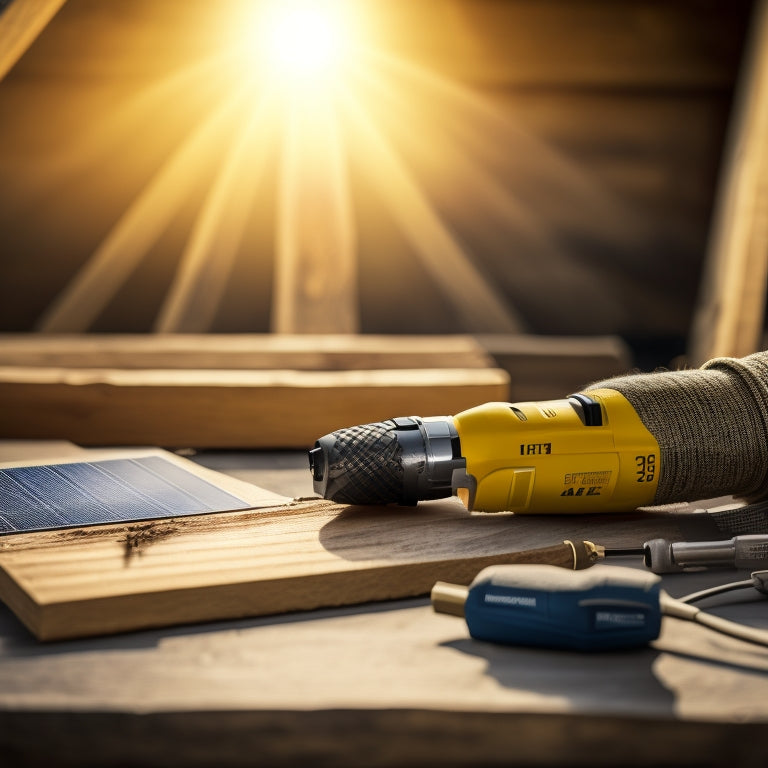
DIY Solar Attic Fan Installation: Step-by-Step Guide
Share
To install a DIY solar attic fan, start by evaluating your attic's ventilation setup, determining the ideal fan size and placement, and examining your existing ventilation systems. Choose a high-quality fan with a high CFM rating and durable solar panels. Prepare your attic by clearing debris, inspecting insulation, and confirming sufficient airflow. Install the solar panel, positioning it for maximum sunlight, and mount the fan near the roof peak. Connect the fan to power, ensuring a reliable energy source, and test its operation. With a successful installation, you're on your way to utilizing the sun's power and reaping the benefits - now, take the next step to optimize your setup.
Key Takeaways
- Assess attic ventilation setup and determine ideal fan size and placement based on roof size and insulation for optimal performance.
- Choose a high-quality solar panel with a high-efficiency rate and durable fan with a comprehensive warranty for reliability.
- Clear the attic of debris and obstructions, inspect insulation for gaps or damage, and confirm sufficient airflow for optimal fan effectiveness.
- Position the solar panel facing south, free from obstructions, and wire the fan according to the manufacturer's instructions for safety.
- Regularly test and maintain the fan, including cleaning the solar panel, inspecting the fan motor and blades, and checking the mounting system for security.
Preparation and Planning Phase
Throughout the process of installing a DIY solar attic fan, the preparation and planning phase is essential in ensuring a successful and efficient installation.
You'll want to assess your attic's current ventilation setup, identifying any potential obstacles or limitations that may impact the fan's performance. Consider factors like roof size, insulation levels, and existing ventilation systems to determine the ideal fan size and placement for maximum energy efficiency.
Proper planning will also help you choose the right location for the fan, ensuring it receives adequate sunlight to power the unit.
Integrating sustainable road trip amenities into your planning can also enhance the overall installation experience.
Choose the Right Solar Fan
Your DIY solar attic fan installation's success relies on selecting the right fan for your attic's unique needs. You want a fan that will efficiently remove heat and moisture, providing you with the solar fan benefits you're looking for.
To guarantee this, take into account the following key factors when choosing your solar fan:
- Fan size: A fan that's too small won't effectively cool your attic, while one that's too large will waste energy. Calculate your attic's square footage to determine the ideal fan size.
Additionally, it's vital to evaluate the impact of solar-powered charging stations on energy independence, achieving energy independence, which can greatly reduce fossil fuel dependence and enhance operational efficiency.
-
CFM rating: Look for a fan with a high CFM (cubic feet per minute) rating to confirm efficient airflow. Regular maintenance, including cleaning and inspecting connections, is important for optimizing performance and guaranteeing longevity, as regular cleaning of solar panels can prevent up to 20% efficiency loss.
-
Solar panel quality: A high-quality solar panel will provide a consistent power supply, even on cloudy days.
-
Durability and warranty: Choose a fan with a durable construction and an extensive warranty to guarantee long-term reliability.
Prepare Your Attic Space
Clear the attic space of any debris, obstructions, or stored items to confirm a safe and efficient installation process.
You'll want to remove anything that could get in the way of your solar attic fan installation or compromise its performance.
Check your attic insulation for any gaps or damage, and make necessary repairs to verify it's functioning properly.
Consider your ventilation strategies, confirming that your attic space has sufficient airflow to maximize the effectiveness of your solar fan.
When designing your ventilation strategy, keep in mind that Cost-Effective Solar Charging Systems can help reduce your reliance on fossil fuels.
Additionally, high-efficiency solar panels can provide a significant amount of energy, making them a great option for powering your attic fan.
Verify that your attic space is well-ventilated, with adequate intake and exhaust points, to create a healthy environment for your new solar attic fan.
Install the Solar Panel
Most solar attic fans come with a pre-assembled solar panel, but if yours doesn't, you'll need to assemble it according to the manufacturer's instructions.
Make sure you choose a suitable location for the panel, ideally facing south and free from obstructions. When selecting a solar panel, consider the type: monocrystalline, polycrystalline, or thin-film. Each has its advantages and disadvantages, so research the best fit for your needs.
Rooftop solar panels, like those used for electric vehicle charging, can reach efficiency rates of up to 22%, maximizing energy production.
You'll need the following installation tools:
- A drill with screwdriver and drill bits
- A tape measure and level
- A wrench or socket set
- Safety glasses and a ladder
Mount the Attic Fan
Two vital components of the solar attic fan system are now in place: the solar panel and the roof penetration.
Now, it's time to mount the attic fan. Confirm the fan is positioned to maximize airflow efficiency by placing it near the roof's peak, allowing hot air to escape easily. Proper fan placement is essential, as it directly affects the system's overall performance.
Additionally, considering the benefits of solar-powered EV charging, such as reducing carbon footprint, can also contribute to a more sustainable and eco-friendly approach in attic fan installation.
You'll want to secure the fan to the roof using the provided mounting brackets and screws. Make sure they're tightened firmly to withstand wind and weather conditions.
Double-check the fan's direction, verifying it's blowing hot air out of the attic, not drawing it in.
Connect the Fan to Power
You'll need to decide on a power source for your solar attic fan, choosing from options like a solar panel, battery, or wall adapter.
Once you've selected a power source, you'll need to wire the fan according to the manufacturer's instructions, ensuring a safe and efficient connection.
Power Source Options
A reliable power source is essential to operate your DIY solar attic fan efficiently. You have multiple options to choose from, each with its benefits and drawbacks.
-
You can connect the fan directly to your home's electrical grid, but this may negate some of the solar energy benefits you're aiming for.
-
A battery backup system guarantees continuous operation during power outages, but adds complexity and cost.
-
You can opt for a standalone solar panel system, which captures the power of the sun to fuel your attic ventilation.
- A hybrid system combines grid power with solar energy, offering a balance between reliability and sustainability.
Wiring the Fan
Now that you've chosen your power source, it's time to connect the fan to its energy supply. Before you start, guarantee you follow wiring safety guidelines to avoid electrical shocks or fires. Familiarize yourself with the fan's wiring diagram and the power source's specifications.
| Fan Type | Wiring Configuration | Power Source |
|---|---|---|
| DC Brushless | Positive (+) to Positive (+), Negative (-) to Negative (-) | Solar Panel or Battery |
| AC Induction | Black (Hot) to Black (Hot), White (Neutral) to White (Neutral) | Grid Power or Inverter |
| DC Axial | Red (Positive) to Red (Positive), Black (Negative) to Black (Negative) | Solar Panel or Battery |
| Hybrid | Consult manufacturer's instructions for specific wiring configuration | Solar Panel and Battery |
| Solar-Powered | Connect directly to solar panel's output | Solar Panel |
Remember to use the correct gauge wire for your fan type and power source to guarantee efficient energy transfer.
Connecting to Battery
Efficiency is key when connecting your DIY solar attic fan to a battery power source.
You'll want to guarantee a seamless and reliable connection to maximize energy storage and minimize power loss. When selecting a battery, consider the following factors:
-
Deep cycle batteries: Opt for deep cycle batteries specifically designed for renewable energy systems, as they can handle the intermittent power supply from your solar attic fan.
-
Battery types: Choose from lead-acid, lithium-ion, or nickel-cadmium batteries, each with their own advantages and disadvantages regarding cost, lifespan, and performance.
-
Capacity and voltage: Select a battery with sufficient capacity to store excess energy generated during the day and provide power during periods of low sunlight or at night, confirming your fan operates within its recommended voltage range.
- Connectors and cables: Use high-quality connectors and cables to minimize energy loss and guarantee a secure, corrosion-resistant connection between your solar attic fan and battery.
Test and Ensure Proper Function
Frequently, homeowners overlook this essential step, but testing and ensuring proper function is crucial to reap the benefits of your DIY solar attic fan installation. Now that you've completed the installation, it's time to put your fan to the test.
| Test | Expected Result |
|---|---|
| Turn on the fan and check for spinning | The fan blades should spin smoothly and quietly |
| Measure the temperature in the attic | The temperature should decrease, indicating proper temperature regulation |
| Check the fan's efficiency | The fan should be running at peak efficiency, reducing your energy bills |
Maintenance and Warranty Tips
With your DIY solar attic fan installation up and running, you've taken a significant step towards reducing your energy bills and regulating your attic's temperature.
Now, it's essential to maintain your system to guarantee peak performance and extend its lifespan. Establish a regular cleaning schedule to remove debris and dust that may accumulate on the solar panel. This will guarantee maximum energy absorption and airflow.
Additionally, review your warranty coverage to understand what's included and for how long.
- Review your warranty coverage to understand what's included and for how long
- Establish a regular cleaning schedule to remove debris and dust that may accumulate on the solar panel
- Check the fan's motor and blades for signs of wear and tear
- Inspect the attic fan's mounting system to verify it remains secure and level
Frequently Asked Questions
Can I Install a Solar Attic Fan in a Metal Roof?
You can install a solar attic fan on a metal roof, but you'll need to take into account metal roof-specific considerations, such as ensuring a watertight seal and using compatible mounting hardware, and follow expert installation tips for a secure and effective setup.
How Long Does a Solar Attic Fan Typically Last?
You'll find that a solar attic fan typically lasts around 15-20 years, depending on factors like quality, installation, and solar fan maintenance, which can greatly impact its lifespan, ensuring efficient performance and freedom from heat and humidity.
Will a Solar Attic Fan Work on Cloudy Days?
Can you truly break free from energy dependence if your solar attic fan falters on cloudy days? Fortunately, you'll find that, although weather impact reduces solar efficiency, most fans still generate some power, ensuring your attic stays ventilated, even on overcast days.
Can I Install a Solar Attic Fan Myself Without Experience?
You can install a solar attic fan yourself without experience, but you'll need the right tools required and take necessary safety precautions to avoid risks.
Are Solar Attic Fans Eligible for Federal Tax Credits?
You're steering through the tax terrain like a sailor charting new waters, and yes, you'll find solar attic fans are eligible for federal tax credits, revealing significant benefits like reducing your tax bill and utilizing the power of solar energy.
Related Posts
-

Why Choose Cool Roofs in Scorching Climates?
You opt for cool roofs in scorching climates because they enable you to reclaim control over your energy consumption ...
-

7 Best Cool Roof Rebates for Energy-Savvy Homeowners
You're an energy-savvy homeowner looking to install a cool roof, and you're wondering which rebates can help you save...
-

What Roofing Materials Best Protect Our Planet?
As you consider the environmental impact of your building, you're likely to find that the roofing material you choose...


